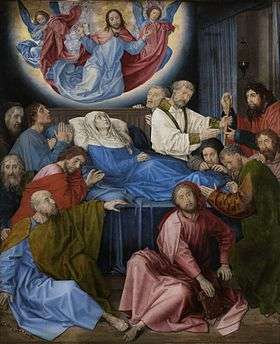Death of the Virgin

The Death of the Virgin Mary is a common subject in Western Christian art, the equivalent of the Dormition of the Theotokos in Eastern Orthodox art. This depiction became less common as the doctrine of the Assumption gained support in the Roman Catholic Church from the late Middle Ages onward. Although that doctrine avoids stating whether Mary was alive or dead when she was bodily taken up to Heaven, she is normally shown in art as alive. Nothing is said in the Bible about the end of Mary's life, but a tradition dating back to at least the 5th century says the twelve Apostles were miraculously assembled from their far-flung missionary activity to be present at the death, and that is the scene normally depicted, with the apostles gathered round the bed.[1][2][3]
A virtuoso engraving by Martin Schongauer of about 1470 shows the Virgin from the foot of a large bed with the apostles spread around the three sides, and this composition influences many later depictions.[4] Earlier depictions usually follow the standard Byzantine image, with the Virgin lying on a simple bed across the front of the picture space. A prominent, and late, example of the subject is Death of the Virgin by Caravaggio (1606), the last major Catholic depiction. Other examples with articles are Death of the Virgin (Mantegna), by Andrea Mantegna, and Death of the Virgin (van der Goes) by Hugo van der Goes. All these show the gathering of the apostles around the deathbed.
Three minor anonymous artists are known to art history as the Master of the Death of the Virgin.
References
- ↑ "The Assumption". Retrieved 2011-10-01.
- ↑ Jameson, Anna (2010-04-22). Legends of the Madonna: As Represented in the Fine Arts. Forgotten Books. pp. 450–480. ISBN 1-4400-8561-7.
- ↑ Pascale, Enrico De; J. Paul Getty Museum (2009-03). Death and resurrection in art. Getty Publications. pp. 363–364. ISBN 978-0-89236-947-8. Check date values in:
|date=(help) - ↑ "Réunion des musées nationaux". Retrieved 2011-10-01.
| Wikimedia Commons has media related to Dormition of Virgin Mary. |